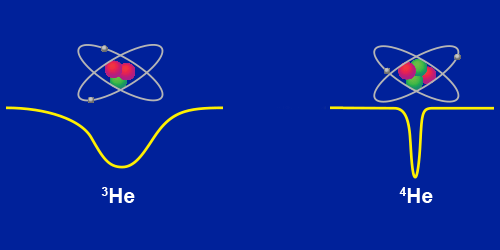Atomic Line Shape Carries Mark of Quantum Statistics
Bosons and fermions are fundamentally different: multiple bosons can all occupy a single lowest energy level, while fermions sequentially fill higher energy levels because of the Pauli exclusion principle. Experimentalists have now detected a theoretically predicted effect of these “quantum statistics” in cold atomic gases of bosons and fermions. A team led by Wim Vassen at Vrije Universiteit Amsterdam measured the same atomic transition in a gas of helium-4 ( He, a boson) and a gas of helium-3 ( He, a fermion), finding a difference between the transition’s line shape in the two gases that agrees with theory. Accounting for this difference is an important step in determining the exact frequency of the transition, which is needed to precisely deduce the size of the helium nucleus.
Vassen and his team focused on a Bose-Einstein condensate (BEC) of He and a degenerate Fermi gas of He. The researchers placed both samples in an infrared optical trap at 200 nK and measured the line shape of an inherently narrow atomic transition that occurs at 1557 nm. Vassen and his colleagues found that the line shape of the transition in He is 5 times wider than that of He, an effect they attributed to differences in quantum statistics: atoms in a Fermi gas have a significantly broader distribution of momenta than those in a BEC. In addition, the researchers also detected and modeled small shifts in the transition’s frequency and width that are induced by the lasers in the experiment. Their next step will be to push the precision of their technique by using an ultraviolet optical trap, in which atoms experience no laser-induced broadening.
This research is published in Physical Review Letters.
–Katherine Kornei
Katherine Kornei is a freelance science writer based in Portland, Oregon.
Correction (16 November 2016): The article was corrected to say that the goal of the measurements is determining the size of the helium nucleus, not precision tests of quantum electrodynamics.





